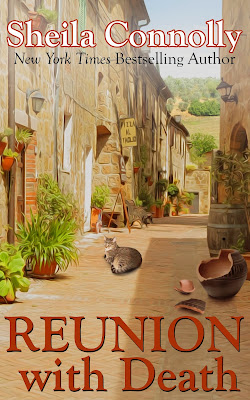I’m supposed to be starting to write a new book, with a deadline of February 1. But “starting” is such a slippery term!
This new book will be the third in a series, which means that the setting and characters are already established, although I have the option (and maybe even the need) to introduce a few new ones.
A plot might be helpful. That’s not to say that the plot doesn’t change during the course of the writing, but I need a starting point, a hook, a key, a precipitating idea that starts the story rolling. It doesn’t have to appear in the first chapter, although it should be close to the beginning, else the writer spends a while meandering around admiring the scenery and introducing the characters (for some readers, not for the first time). Note: the body doesn’t have to be appear in the first chapter either, although that does make a striking start, giving you the opportunity to explore the who and the why immediately. Who is this person covered with blood, and what’s he doing lying on my floor? I’ve ever seen him before!
But I do write murder mysteries, therefore there should be a murder. That means I have to decide what concept is worthy of killing someone for. I assume the cast of characters—both official and amateur—will be able to solve it, but I have to give them a crime to solve.
All this sounds as though I know what I’m doing; that I plan ahead and know where a story is going to go when I first open that first file or type “Chapter 1.” I don’t.
I sent off edits to two books last week, so those books are essential done, save for some proofing. Sigh of relief. Now, what do I do with some free time? Worry—about getting the next book started. But after writing quite a few books, I’ve discovered something: if I wait for it, the book starts demanding to be written. It’s not a conscious process, but if I turn my attention to something else (like polishing the furniture or raking leaves), a scene will start jelling in my head. I have to work from the beginning, although I do visualize snippets of what will follow, so the first scene is first to emerge, like an (old-fashioned!) photo materializing on the paper in a tray of developer.
And that’s where I am right now. I “see” the opening scene, and I see how it leads to the one that follows and the one after that. No body yet, although I think I know who dies, and the new character that will lead us to the murder appears up front. That first chapter is a tricky one, because I have to fill in just the right amount of backstory (who are these people and why should I care? sez the reader) and also kick off the action so the story moves forward. I have to make sure that I don’t depart from the personalities of the existing characters—a person can’t have been morose for the entire last book and suddenly become cheerful, or not without a good reason, which would probably be a clue to something. I have to remind readers why they liked the last book in the series enough to pick up this next one.
I know the scene in my head is the place to start because it won’t go away. I have to set it down. It’s almost a physical itch, to put my fingers on the keys and get started, and writing anything but that chapter just won’t do.
So, in the third County Cork book (still nameless), Maura Donovan is sitting at the well-worn kitchen table in the century-old cottage in Ireland that she inherited, trying to figure out how she can possibly afford to keep her pub running on the paltry profits she’s been making over the past few months—and she doesn’t know that the answer is sitting on a barstool at the pub waiting for her.













5 comments:
Great cover for Reunion, Sheila--though I had to chuckle at the inevitable cat.
We had fun with that cat, Liz. The artist kept moving it around and changing its size, so at one point we were calling it the alien hover-cat. But I took plenty of cat pictures in Italy, including one of a tabby sleeping peacefully outside a carabinieri station, so at least they're authentic.
What's cat in Irish Gaelic?
Cat (yes, really). Of course, the spelling changes in combination with other words, like "Ta an gcat sa teach" which means "the cat is in the house."
Dog, on the other hand, is madra.
Don't ask me what either one is in Italian!
Gato and cano, I think!
Post a Comment